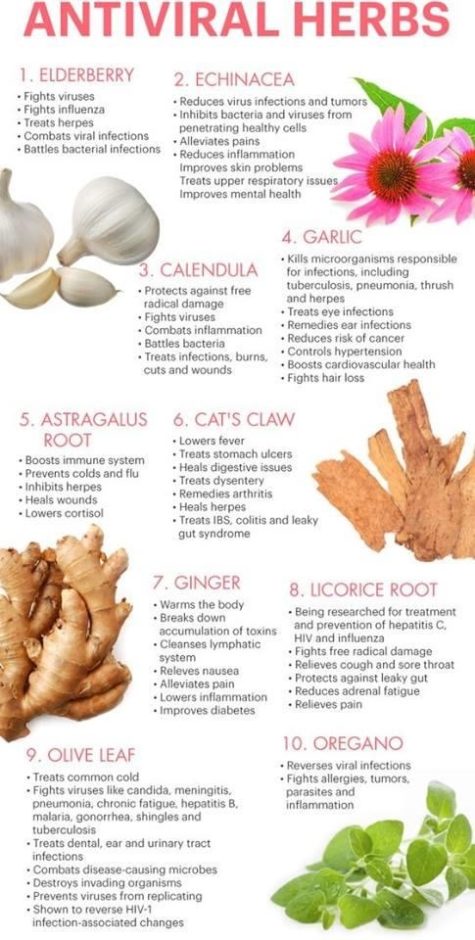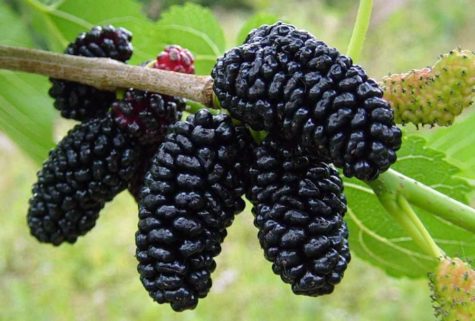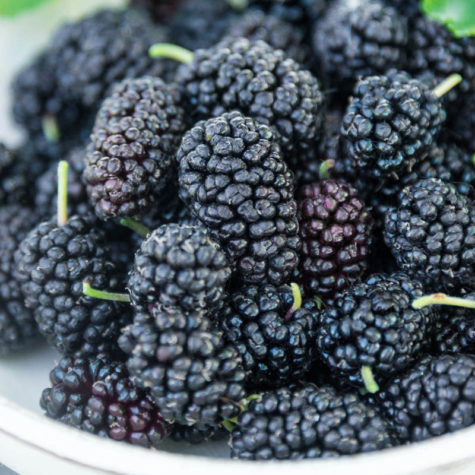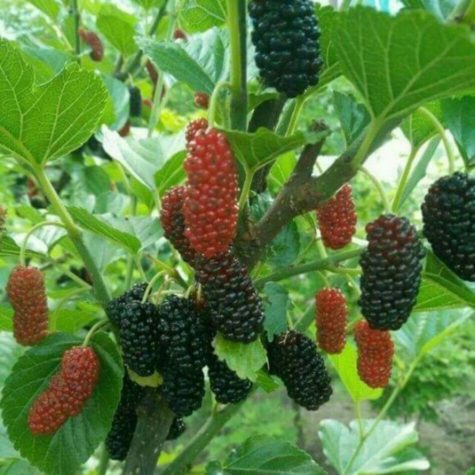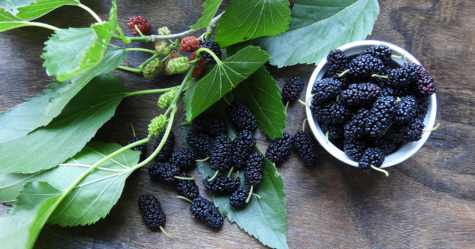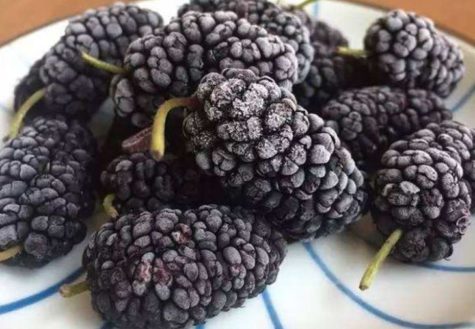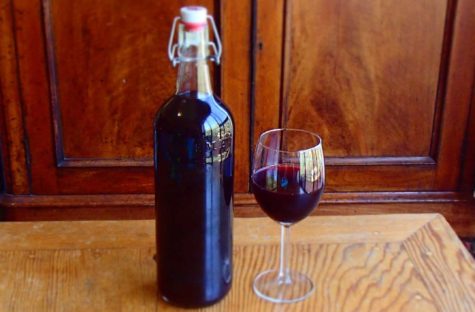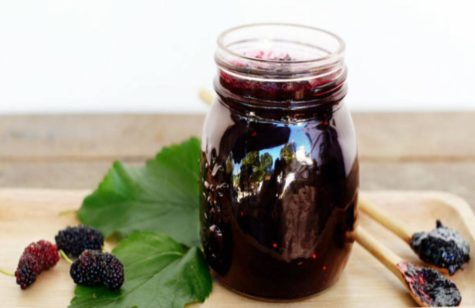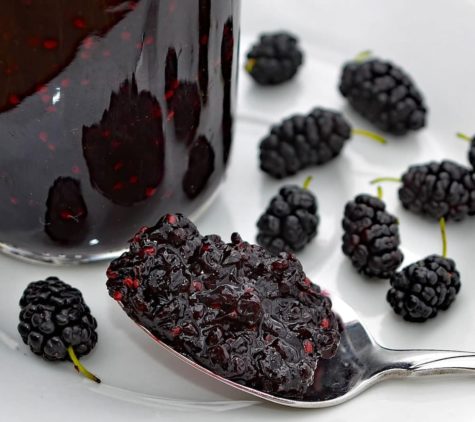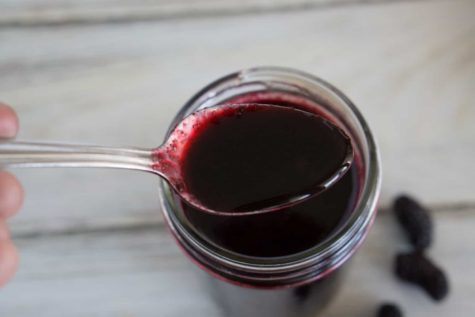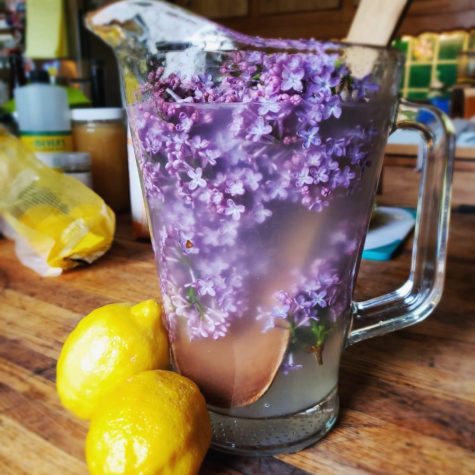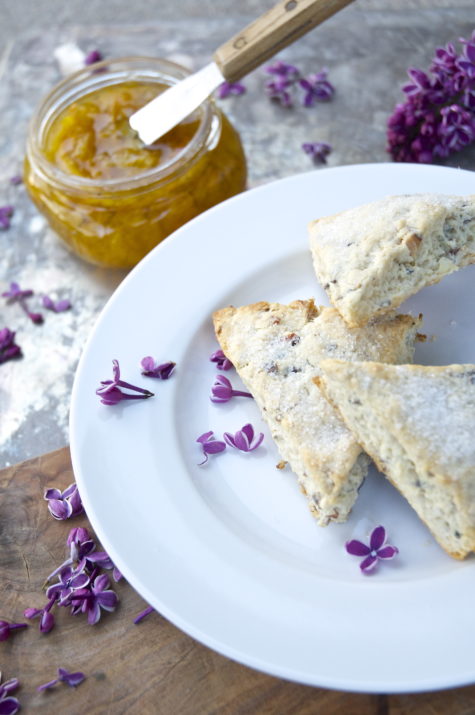Antiviral Herbs
Mulberries Are Good For You
Mulberries are very high in antioxidants. They also contain large amounts of vitamin C as well as Vitamin K, Vitamin A, Vitamin E, really high levels of Iron, and Dietary Fiber and are high in minerals like potassium, manganese, and magnesium and contain the B vitamins, B6, Niacin, Riboflavin, and Folic Acid. Mulberries contain flavinoids and phyto-nutrients and are extremely high in anthocyanins.
A 3 1/2-ounce serving of raw Mulberries has 43 calories, can provide up to 44 percent of your daily value of vitamin C, and 14 percent of your iron needs. The fruit and leaves are sold in various forms as nutritional supplements. The mature plant contains significant amounts of resveratrol, particularly in the stem bark, which some speculate can lead to longevity.
- Improve Digestive Health
Mulberries are a boon for your stomach. They relieve constipation and are also an excellent way to lose weight. Mulberries contain a good amount of dietary fiber. Your body needs dietary fiber to facilitate proper digestion. It does so by bulking up a stool in the stomach and facilitating the movement of food through the digestive tract. This process helps in relieving constipation, bloating, and stomach cramps.
Healthy digestion helps in efficiently maintaining optimum weight. A research was conducted by Italy’s F. De Ritis Institute and the Catholic University of Sacred Heart to determine the weight loss capacity of Mulberries. It was found out that those who consumed Mulberries as part of a balanced diet plan of 1300 calories decreased to about 10% of their total body weight in nearly three months.
The researchers also noticed that the group which consumed Mulberries reduced drastically in the waist and thigh regions. So, all you people who want a slender waist and toned thighs, you know what to eat.
- Lower Cholesterol
Eating Mulberries is a good way to lower the levels of bad cholesterol in your body, which in turn helps in preventing cardiovascular problems.
- Control Blood Sugar Levels
White Mulberries, in particular, help in keeping a check on the sugar levels of the body. Certain chemicals present in white Mulberries are similar to the medicine used to treat type 2 diabetes.
These compounds in white Mulberry help in keeping the sugar levels of the body at an optimum range by slowly breaking down the sugars in the gut and allowing them to be absorbed slowly into the blood.
- Reduce Cancer Risk
If you are looking to protect yourself from cancer, then Mulberry is what you should be looking for. Mulberries are rich in antioxidants and phytonutrients that help in stopping the growth and spread of tumor cells and protect you from cancer.
Mulberries are full of anthocyanins that help in keeping cancer cells at bay. They also contain resveratrol, which has anti-cancer properties. Resveratrol cancer inhibiting properties help in fighting colon cancer, skin cancer, prostate cancer, and thyroid.
- Improve Blood Circulation
Mulberries improve blood flow through the body, control blood pressure, and cleanse the blood. The antioxidants present in Mulberries help in improving the function of the blood vessels by keeping them supple and dilated, which leads to blood pressure control as there is a free flow of blood from the heart to other parts of the body. Mulberries encourage the production of red blood cells as they are rich in iron.
Mulberries contain polyphenols that keep the blood vessels healthy. They also contain potassium, which lowers the blood pressure.
Mulberries have been used as a remedy for blood health since ages. Ancient Chinese medicine incorporated them in their blood tonics that were used to cleanse the blood and increase its production.
- Cure Anemia
Mulberries are great for curing anemia as they are rich in iron. They also cure the symptoms of anemia such as fatigue and dizziness.
- Better Heart Health
The fiber, antioxidants, and flavonoid content of Mulberries facilitate heart health. They help in maintaining a consistent flow of blood, thus preventing heart attacks and strokes. Mulberries are rich in polyphenols, which are considered healthy for the heart.
- Good For Vision
Like carrots, Mulberries too are good for your eyes. They improve your vision and protect your eyes from free radicals that are a cause of retinal degeneration and loss in eye sight. Mulberries contain zeaxanthin, which helps in reducing oxidative stress in the cells that form your eyes. The carotenoids present in Mulberries assist in preventing cataracts and macular degeneration.
- Promote Brain Health
Research suggests that Mulberries age-proof the brain, keeping it young and alert. They also provide the calcium needs of the brain, hence keeping it hale and healthy. Mulberry also makes for an excellent treatment to keep Alzheimer’s at bay.
- Improve Immunity
Mulberries help in improving the immune system by activating the macrophages through the alkaloids present in them. Macrophages keep the immune system alert at all times. Mulberries also contain Vitamin C, which is another immunity strengthening element.
- Build Bone Tissue
Mulberries contain Vitamin K, calcium, and iron, which is the best combination of nutrients to maintain and build strong bone tissues and bones. These nutrients help the bones reverse the signs of bone degradation and prevent bone disorders such as osteoporosis, arthritis, etc.
- Rich Source Of Antioxidants
Mulberries contain an abundance of antioxidants. They contain a high concentration of the powerful antioxidant resveratrol, which is a natural antibiotic and helps in reducing heart risks. It also keeps a check on the blood pressure.
- Prevent Flu And Cold
Flu and cold are a menace. Don’t you agree? Well, eating Mulberries could solve that problem for you. The white Mulberry fruit, in particular, has been used in folk remedies for cold. White Mulberries are considered to be an astringent, bactericide and tonic and work correctly to prevent and treat flu and cold. They also contain Vitamin C and flavonoids, which prevent cold and flu.
- Improve Liver Health
Mulberries can be used to make a blood tonic, because when consumed, they nourish and purify the blood in the liver. Mulberries have the ability to strengthen the liver, and also contain iron that works well to maintain the liver health.
- Are An Anti-Inflammatory Agent
The presence of resveratrol in Mulberries induce anti-inflammatory properties in it. Mulberries also contain anthocyanins that help in preventing inflammation. Mulberries are sometimes even used as a natural alternative to allopathic anti-inflammatory drugs.
- Effective Anti-Aging Agent
Mulberries have the ability to make you look young and fresh. They contain resveratrol, which protects the skin from harmful UV rays.
Mulberries are abundant in antioxidants, which are great anti-aging agents. They keep your skin blooming and free of wrinkles. The antioxidants in Mulberries such as beta-carotene neutralize the free radicals that damage skin and cause fine lines.
Mulberries also provide vitamins A, C and E, lack of which leads to wrinkles.
- Clear Out Dark Spots And Blemishes
The antioxidants in Mulberries prevent the occurrence of blemishes on the skin. Mulberries help regulate the melanin synthesis in your skin, which naturally clears off the dark spots. They contain antioxidants that moisturize, unclog pores, and remove toxins from your skin, keeping it fresh and vibrant. Mulberries effectively even out your skin and make it look naturally beautiful and healthy.
- Treat Dry And Sensitive Skin
Lack of Vitamins A and E cause dry skin. Mulberries are rich in those vitamins, and help in treating dry and delicate skin. They hydrate your skin from within. Mulberry root extracts soothe irritated skin.
- Make Skin Soft And Radiant
You can simply sit and eat a bowl of Mulberries every day to get soft and radiant skin because they are rich in minerals that provide elasticity, flexibility, and nourishment to the skin.
- Promote Hair Growth
The presence of antioxidants in Mulberries help in keeping your hair healthy, promote hair growth, and prevent breakage.
- Help In the Retention Of Natural Hair Color
Mulberries, in combination with some traditional Chinese herbs, can help in preventing early hair graying. The nutrients in Mulberries such as calcium, iron, Vitamin C, and B play a vital role in doing so.
Practical Uses
The ripe fruit is a great snack for humans, right off the tree. Mulberries are extremely juicy and have a refreshing, subacid, saccharine taste, but they do not have the fine aroma that distinguishes many fruits.
Of all the berries that exist, Mulberries have the highest content of antioxidants, making them healthy no matter how you prepare them.
Here are some Mulberry recipes:
- Mulberry Syrup
- Old Fashioned Mulberry Jam
- Simple Mulberry Jam
- An Easy Mulberry Sorbet
- A Nice Mulberry Sorbet
- Mulberry Wine
These blackberry-like morsels provide 60 calories per cup, with 85 percent of your daily requirement of Vitamin C and 14 percent of your daily Iron. Make sure they are ripe and sweet, because under-ripe Mulberries can lead to serious reactions like vomiting, diarrhea, and hallucinations.
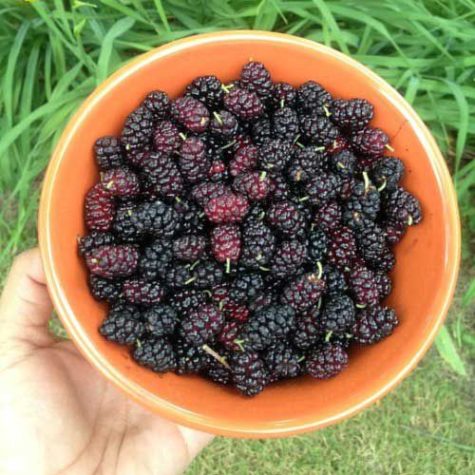
Collecting and Conserving
For all their deliciousness, Mulberries are delicate, perishable, labor-intensive to pick, and don’t all ripen at the same time. All of these factors contribute to the difficulty of commercially growing and harvesting these berries. They aren’t the kind of berry you’ll typically find in the grocery store, unless it’s a local specialty or gourmet outlet.
When they are ripe, you can harvest them by hand if you are lucky enough to have a tree. Place a tarp underneath the tree and gently shake the branches to loosen the ripe fruit. Some may come off, some may stay; they don’t all ripen at the same time, and some that are ripe may need a little coaxing off their stems.
The berries are very delicate and therefore need to be handled carefully so that they don’t break open – the stain won’t wash out.
Dried Mulberries are often sold at health food stores or natural, organic grocery chains, sometimes in the bulk section. They can also be purchased online in bulk.
- Storage
If you can manage not to eat them all, they’ll keep in the fridge for two to three days, unwashed, and in a covered container.
As the saying goes, when life gives you lemons, you make lemonade. And when Mulberry trees produce more fruit than you can consume, or perhaps you get lucky and score a surplus through your own devices (friends with trees, maybe?), you make jam. But there’s only so much you can make.
Here are some handy ways to conserve these first fruits of summer.
- Dry Them
Cover your dehydrator trays or a few window screens with these berries and dry them to create a sweet dried snack. For best results, apply a little Fruit Fresh or a similar vitamin C powder to discourage spoiling and spike the nutritional value.
Store the dried Mulberries in a breathable container like a paper bag, cloth sack, or wooden box to keep them from sweating and subsequently molding. Never eat any moldy dehydrated foods.
- Freeze Them
These berries will keep for six months in the freezer. Pop them frozen into smoothies or prep them in a yogurt-granola parfait in the fridge, where they can defrost and their color and flavor will naturally permeate the yogurt.
Mulberries are only in season for a few weeks in late spring and early summer. The fruit is used to make pies and tarts, as well as wines and cordials. But because of the berry’s brief season, we can only enjoy their slightly tart and refreshing taste for a short amount of time—unless we can preserve them for later use.
Freezing is the easiest way to preserve Mulberries, and whether you use fresh or frozen Mulberries, the results will be delicious.
Mulberries almost always come off of the tree with a little bit of stem attached. You can leave on the stem—it will not affect the berry—or, you can take the time to remove the stem bits before freezing. No matter, follow a few steps to ensure your Mulberries are easy to use when needed.
- Wash the Mulberries
Before placing in the freezer, you need to wash the Mulberries; washing removes bacteria that could be lurking on the berries, such as salmonella, E. coli, or norovirus. Run the berries under cool water and let them drain for a few minutes in a colander.
- Single-Layer Freeze
Freezing the berries in a single layer will ensure that the berries will remain separate once they are frozen. Spread the whole, washed Mulberries in a single layer on a baking sheet or on plates. Freeze the fruit, uncovered, for at least 2 hours.
- Transfer to Freezer Containers
Once the berries are frozen, you can transfer them to freezer bags or containers. (It is recommended that you use BPA-free, non-plastic freezer containers.) Make sure to label and date the bags or containers; you can store Mulberries in the freezer for up to 6 months. They are still fine to eat after that, but their quality and flavor degrade over time.
- Ways to Use Frozen Mulberries
There are many ways you can use the frozen Mulberries, from smoothies to baked goods to jam. You can blend straight-out-of-the-freezer Mulberries with milk (or a non-dairy alternative), yogurt, and honey or another sweetener of your choice. The frozen berries will give the smoothie a thick, cold, milkshake-like texture.
You can also add still-frozen Mulberries to pancakes, muffins, and quick bread. Although the Mulberries will cook along with the rest of the ingredients, berries that start out frozen in these recipes will not bleed their color as much as fresh berries tend to do.
Frozen Mulberries are just as good as fresh for making Mulberry jam and other sweet preserve recipes. Stockpile them in the freezer during the harvest season, and get around to that jam project later when you have time.
You can use the frozen Mulberries to make sorbet or ice cream, but you will need to thaw them before you transform them into a frozen dessert. You can also thaw frozen Mulberries and puree them to make a simple, flavorful sauce to spoon over yogurt, cake, or fresh fruit. If you think the sauce needs it, add a little honey or sugar and a small squeeze of lemon juice to intensify the Mulberry flavor.
Source: Encyclopedia of Herbology
Mulberry Wine
If you are comfortable with the idea of wine making, here’s a simple recipe you might want to try:
Combine 2 pounds of Mulberries, 2 pounds of sugar, and 3 quarts of water in a stainless steel or enamel pot. Bring to a boil and keep boiling for 20 minutes.
Cool the mixture to room temperature and pour through a strainer into a sanitized one-gallon glass jug. Top off with clean water if needed, and add red wine yeast when the liquid is 80 degrees Fahrenheit or cooler.
Fit a water-filled wine lock to the jug mouth, and ferment in a dark, room-temperature spot for six weeks.
For best taste, decant the wine into bottles and age for a few months. Though you could enjoy the “new” wine right away.
A Nice Mulberry Sorbet
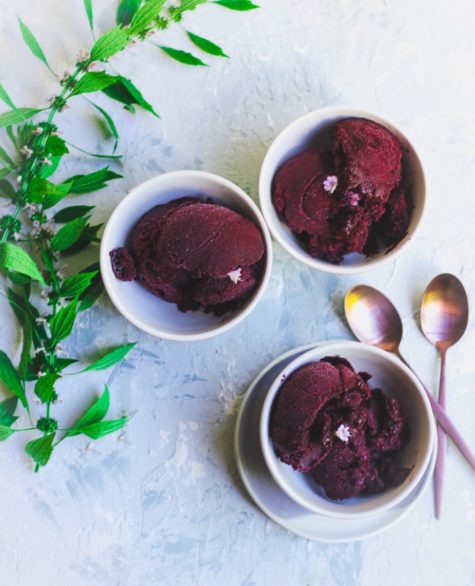
Sorbets make for a perfect ending to a meal or to eat away when you feel like having something ice-cream like but without the calories.
- 1 cup sugar
- 1 cup water
- 5 cups Mulberries
- 2 tablespoons Port Wine
Instructions:
Clean the Mulberries and set them aside. Boil sugar and water in a container with medium heat. Simmer it for 3 to 4 minutes.
Turn the heat off and let it cool. While the sugar syrup is cooling, pick off all the green stems from the Mulberries.
Blend the Mulberries and pour the sugar syrup on the Mulberry paste. Make it into a puree. Sieve the Mulberry puree to remove any residual seeds or stems.
Pour a bit of Port Wine into it and chill the mixture in the freezer for about an hour. Then, pour it into an ice cream maker and whip up a sorbet.
An Easy Mulberry Sorbet
Beat the summer heat with a cool and scrumptious Mulberry Sorbet. This is an easy recipe which is made with mulberries and honey.
Here’s what you will need:
- An ice crushing blender or a small food processor
- 8 oz frozen Mulberries
- 3 to 4 tablespoons simple syrup as a sweetener (or agave or honey or maple syrup)
- And just a squeeze of lemon juice or lime juice
You don’t need an ice cream maker for this recipe because you’re making small batches of sorbet. The blender will be crushing the frozen fruit to very small pieces to make it almost as small as with an ice cream maker.
- Roughly weigh out the frozen fruit and place it in a small food processor or ice crushing blender.
- Pulse to crush the fruits into small pieces and add the sweetener, a tablespoon at a time (while pulsing) to create a smooth sorbet-like paste.
- Add a squeeze of lemon juice and run the blender for a few seconds to mix.
- In addition to the sweeteners, you can add water or orange juice or lemonade IF your blender needs a little extra liquid to make that sorbet!
This recipe for sorbet is best eaten immediately – straight after blending.
- Note: Traditional sorbet has a lot more sugar added to it, to allow the sorbet to be softer in consistency and scoopable even when frozen.
Because this easy fruit sorbet has far less sugar than a traditional sorbet, it will harden more when frozen. But it will be just like sorbet as soon as it’s blended! So it’s perfect as an easy alternative for sorbet and a quick and healthy, refreshing summer snack or treat!
However, you can freeze it for later too. You will have to let the sorbet soften a little at room temperature so that it can be scooped easily.
From: The Flavor Bender
Simple Mulberry Jam
Here is a really simple recipe for Mulberry Jam.
Wash the mulberries and keep them in a bowl. Add lemon juice to the bowl and mix.
Now put the mixture over medium flame in a pan for about 12-15 minutes. Add the sugar into mulberries and stir well. Cook it till the mixture becomes thick and consistent.
Remove from heat and cool down the mixture. Once done, transfer into jar and refrigerate.
From: Times of India
Old Fashioned Mulberry Jam
Here is a very old recipe for Mulberry Jam, as give in A Modern Herbal by M Grieve:
- Note: Unless very ripe Mulberries are used, the jam will have an acid taste.
Put 1 pound of Mulberries in a jar and stand it in a pan of water on the fire until the juice is extracted. Strain them, and put the juice into a preserving pan with 3 pounds of sugar.
Boil it and remove the scum.
Put in 3 pounds of very ripe Mulberries and let them stand in the syrup until thoroughly warm. Then set the pan back on the fire and boil them very gently for a short time, stirring all the time and taking care not to break the fruit.
Then take the pan off and let them stand in the syrup all night. Put the pan on the fire again in the morning and boil again gently until stiff.
Mulberry Syrup
Sweet Mulberry syrup is excellent over pancakes, ice cream, and other foods. Here’s how to make it:
Mash one pint of berries in a cooking pot, add 2 cups of white sugar, and bring the mix to a boil for 10 minutes. No water is needed as the berries are juicy enough. Stir constantly to prevent burning. While the mix is still hot, pour through a strainer into a clean jar.
This is your finished syrup! Store it in the fridge for up to two months. Discard after that, or if it grows mold.
Source: Encyclopedia of Herbology
Lilac Lemonade
Lilac lemonade is very easy to make. If you have ever had lavender lemonade, this lemonade actually tastes very similar.
To make this easy lemonade, you will need about 2 cups of fresh Lilac blossoms. Make sure to pick Lilacs that have not been sprayed with any chemicals. Wash them to remove any insects and gently pull off the Lilac blossoms to make two cups.
Ingredients:
- 2 cups fresh Lilac blossoms
- 1 cup sugar or honey
- 16 cups water
- Juice of 4 lemons
To really get the flavor of the Lilac blossoms, you will need to boil the blossoms like you would to make tea. Place the Lilac blossoms in a sauce pan and cover them with water. Bring the water to a boil.
Remove the pan from the heat and let it sit for about 20 minutes. The longer you let it sit, the stronger the Lilac flavor will be. Strain the Lilac blossoms out of the water with a fine mesh strainer.
Place the liquid in a 1 gallon container and add the sugar or honey, lemon juice, and remaining water. Stir. Refrigerate until ready to serve. Garnish with a sprig of fresh Lilac flowers if desired.
You can also freeze fresh Lilac flowers in water in an ice cube tray, putting 2 or 3 of the tiny florets in each cube. This makes a cute way to dress up your Lilac Lemonade.
Notes:
This recipe is made with fresh Lilac blossoms. If you want to preserve your Lilac blossoms to make Lilac lemonade when your Lilacs are out of season, then see the the following posts for:
This recipe makes approximately 1 gallon of lemonade. You can cut the recipe in half, and you can also adjust the recipe to suit your tastes if you would like to use less sugar or more lemon juice.
Found at: Creative Homemaking
Lilac Blossom Scones
Ingredients:
- 3 cups flour, all-purpose
- 1/3 cup sugar
- 2 1/2 teaspoons baking powder
- 1/2 teaspoon baking soda
- One teaspoon salt
- 12 tablespoons unsalted butter, chilled
- 1 cup buttermilk, shaken well
- One teaspoon vanilla extract
- 1/2 cup toasted, chopped almonds
- 1 cup lilac flowers
Preheat your oven to 425 degrees.
In a large mixing bowl, combine the flour, sugar, baking powder, baking soda, and salt. Whisk the ingredients together. Cut the chilled butter into small cubes and toss into the dry mixture. Using your fingers and hands, work the butter into the flour mixture, until pea-sized lumps of butter are present.
Add the buttermilk, vanilla extract, almonds, and lilac blossoms. Fold together in the bowl. I kneaded the dough by hand, making sure to not over-work.
Gather and roll the dough into a ball. Lightly flour the ball of dough and flatten it out, by hand, into a 1/2 inch thick disk. Cut the dough into triangles and place onto a greased baking sheet.
Lightly dust with raw sugar. I greased my sheet with butter. Bake 12 to 16 minutes, until desired level of toastiness.
Found at: Holly and Flora
